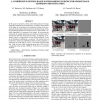Free Online Productivity Tools
i2Speak
i2Symbol
i2OCR
iTex2Img
iWeb2Print
iWeb2Shot
i2Type
iPdf2Split
iPdf2Merge
i2Bopomofo
i2Arabic
i2Style
i2Image
i2PDF
iLatex2Rtf
Sci2ools
ICIP
2009
IEEE
2009
IEEE
A compressive-sensing based watermarking scheme for sparse image tampering identification
In this paper we describe a robust watermarking scheme for image tampering identification and localization. A compact representation of the image is first produced by assembling a feature vector consisting of pseudo-random projections of the decimated image. Then, the quantized projections are encoded to form a hash, which is robustly embedded as a watermark in the image. By recovering the watermark the random projections are obtained, and then used to estimate the distortion of the received image. If tampering is sufficiently sparse or compressible in some basis description, a map of the introduced modification is recovered. The system relies on Compressive Sensing and Distributed Source Coding principles to reduce the size of the hash of a 1024
| Added | 19 Feb 2011 |
| Updated | 19 Feb 2011 |
| Type | Journal |
| Year | 2009 |
| Where | ICIP |
| Authors | Giuseppe Valenzise, Marco Tagliasacchi, Stefano Tubaro, Giacomo Cancelli, Mauro Barni |
Comments (0)

